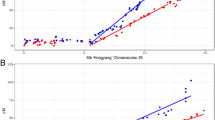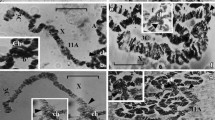Summary
The isolation of homozygous-viable pericentric inversions for inclusion in field-female killing (FK) systems in Lucilia cuprina is described. From 7,236 irradiated chromosomes screened, 16 pericentric inversions were isolated. Four of these were viable as homozygotes. One of these, In (3LR) 14, possesses the properties required for inclusion in FK systems (tight linkage of one inversion break-point to the white-eye gene and substantial genetic exchange within the inversion in heterozygous females).
Similar content being viewed by others
References
Baker RH, Reisen WK, Sakai RK, Hayes CG, Aslamkhan M, Saifuddin UT, Mahmood F, Perveen A, Javed S (1979) Field assessment of mating competitiveness of male Culex tritaeniorhynchus carrying a complex chromosomal aberration. Ann Entomol Soc Am 72:751–758
Baker RH, Reisen WK, Sakai RK, Rathor HR, Raana K, Azra K, Niaz S (1980) Anopheles culicifacies: mating behaviour and competitiveness in nature of males carrying a complex chromosomal aberration. Ann Entomol Soc Am 73:581–588
Bedo DG (1982) Differential sex chromosome replication and dosage compensation in polytene trichogen cells of Lucilia cuprina (Diptera: Calliphoridae). Chromosoma 87:21–32
Bedo DG, Howells AJ (1987) Chromosomal localisation of the white gene of Lucilia cuprina (Diptera; Calliphoridae) by in situ hybridisation. Genome 29:72–75
Boussy IA (1988) A Drosophila model of improving the fitness of translocations for genetic control. 1. Autosomal translocations with euchromatic breakpoints. Theor Appl Genet 76: 627–639
Busch-Petersen E (1989) Male recombination in a genetic sexing strain of Ceratitis capitata (Diptera: Tephritidae) and its effect on stability. Ann Entomol Soc Am 82:778–784
Busch-Petersen E (1990) Temperature-sensitive lethal factors and puparial colour sex separation mechanisms in the Mediterranean fruit fly, Ceratitis capitala (Wied.). In: Genetic sexing of the mediterranean fruit fly. IAEA, Vienna, pp 115–127
Curtis CF, Akiyama J, Davidson G (1976) A genetic sexing system in Anopheles gambiae species A. Mosq News 36:492–498
Foster GG (1989) The sheep blowfly genetic control program in Australia. FAO/IAEA Insect & Pest Control Newsletter No. 43, pp 23–26
Foster GG (1991a) Chromosomal inversions and genetic control revisited: The use of inversions in sexing systems for higher Diptera. Theor Appl Genet 81:619–623
Foster GG (1991b) Simulation of genetic control. Homozygousviable pericentric inversions in field-female killing systems. Theor Appl Genet (in press)
Foster GG, Whitten MJ (1991) Meiotic drive in Lucilia curpina and chromosomal evolution. In: Proc Conf Gent Biol Meiotic Drive, Honolulu, January 1988. Am Nat 137:403–415
Foster GG, Whitten MJ, Vogt WG, Woodburn TL, Arnold JT (1978) Larval release method for genetic control of the Australian sheep blowfly Lucilia curpina (Wiedemann) (Diptera: Calliphoridae). Bull Entomol Res 68:75–83
Foster GG, Maddern RH, Mills AT (1980a) Genetic instability in mass-rearing colonies of a sex-linked translocation strain of Lucilia cuprina (Wiedemann) (Diptera: Calliphoridae) during a field trial of genetic control. Theor Appl Genet 58:169–175
Foster GG, Whitten MJ, Konovalov C, Bedo DG, Maddern RH, Boon DJ (1980b) Cytogenetic studies of Lucilia cuprina dorsalis R.-D. (Diptera: Calliphoridae). Polytene chromosome maps of the autosomes and cytogenetic localization of visible genetic markers. Chromosoma 81:151–168
Foster GG, Whitten MJ, Konovalov C, Arnold JTA, Maffi G (1981) Autosomal genetic maps of the Australian sheep blowfly, Lucilia cuprina dorsalis R.-D. (Diptera: Calliphoridae), and possible correlations with the linkage groups of Musca domestica L. and Drosophila melanogaster (Mg.). Genet Res Camb 37:55–69
Foster GG, Vogt WG, Woodburn TL (1985) Genetic analysis of field trials of sex-linked translocation strains for genetic control of the Australian sheep blowfly Lucilia cuprina (Wiedemann). Aust J Biol Sci 38:275–293
Foster GG, Vogt WG, Woodburn TL, Smith PH (1988) Computer simulation of genetic control. Comparison of sterile males and field-female killing systems. Theor Appl Genet 76:870–879
Foster GG, Weller GL, Clarke GM (1991) Male crossing over and genetic sexing systems in Lucilia cuprina. Heredity (in press)
Hooper GHS, Robinson AS, Marchand RP (1987) Behaviour of a genetic sexing strain of Mediterranean fruit fly, Ceratitis capitata, during large-scale rearing. In: Fruit flies. Proc 2nd Int Symp, 16–21 September 1986, Colymbari, Crete, pp 349–362
Kaiser PE, Seawright JA, Dame DA, Joslyn DJ (1978) Development of a genetic sexing system for Anopheles albimanus. J Econ Entomol 71:766–771
Konovalov CA, Foster GG, Whitten MJ (1983) Viability and fertility of sex-linked autosomal duplications in Lucilia curpina (Wiedemann). Theor Appl Genet 65:9–16
Lefevre G Jr (1974) The one band-one gene hypothesis: evidence from a cytogenetic analysis of mutant and nonmutant rearrangement breakpoints in Drosophila melanogaster. Cold Spring Harbor Symp Quant Biol 38:591–599
Lindsley DL, Grell EH (1968) Genetic variations of Drosophila melanogaster. Carnegie Institute of Washington Publ. No. 627, 472 pp
Lindsley DL, Sandler L, Baker BS, Carpenter ATC, Denell RE, Hall JE, Jacobs PA, Miklos GLG, Davis BK, Gethmann RC, Hardy RW, Hessler A, Miller SM, Nozawa H, Parry DM, Gould-Somero M (1972) Segmental aneuploidy and the genetic gross structure of the Drosophila genome. Genetics 82:157–184
Maddern RH, Foster GG, Whitten MJ, Clarke GM, Konovalov CA, Arnold JTA, Maffi G (1986) The genetic mutations of Lucilia cuprina dorsalis R.-D. (Diptera: Calliphoridae). Commonwealth Scientific and Industrial Research Organization, Australia Division of Entomology Report No. 37, 40 pp
Rabbani MG, Seawright JA, Kitzmiller JB (1977) X-ray induced pericentric inversions in Anopheles albimanus. Can J Genet Cytol 19:67–74
Roberts PA (1967) A positive correlation between crossing-over within heterozygous pericentric inversions and reduced egg hatch of Drosophila females. Genetics 56:179–187
Roberts PA (1970) Screening for X-ray-induced crossover suppressors in Drosophila melanogaster: prevalence and effectiveness of translocations. Genetics 65:429–448
Robinson AS (1975) A reassessment of the use of chromosome inversions for insect control. J Hered 66:35–37
Robinson AS, Van Heemert C (1982) Ceratitis capitata — a suitable case for genetic sexing. Genetica 58:229–237
Robinson AS, Malcolm C, Groenestijn P, Schelling G (1986) Breakpoint distribution in male-linked translocations in Anopheles stephensi Liston. J Hered 77:394–398
Rossler Y (1979) Automated sexing of the Mediterranean fruit fly, Ceratitis capitata (Diptera: Tephritidae): the development of strains with inherited, sex-linked pupal color dimorphism. Entomophaga 24:411–416
Rossler Y (19821) Genetic recombination in males of the Mediterranean fruit fly, and its relation to automated sexing methods. Ann Entomol Soc Am 75:28–31
Rossler Y (1982b) Recombination in males and females of the Mediterranean fruit fly (Diptera: Tephritidae) with and without chromosomal aberrations. Ann Entomol Soc Am 75: 619–622
Saul SH (1984) Genetic sexing in the Mediterranean fruit fly Ceratitis capitata (Wiedemann) (Diptera: Tephritidae): conditional lethal translocations that preferentially eliminate females. Ann Entomol Soc Am 77:280–283
Suguna SG, Seawright JA (1980) Radiation-induced inversions on chromosome 3 of Anopheles albimanus. Mosq News 40:372–376
Suguna SG, Seawright JA, Joslyn DJ, Rabbani MG (1981) Homozygous pericentric inversions and other studies of inversions on chromosome 3 in the mosquito Anopheles albimanus. Can J Genet Cytol 23:57–64
Whitten MJ (1969) Automated sexing of pupae and its usefulness in control by sterile insects. J Econ Entomol 62:272–273
Whitten MJ (1979) The use of genetically selected strains for pest replacement or suppression. In: Hoy MA, McKelvey JJ Jr (eds) Genetics in relation to insect management. The Rockefeller Foundation, New York, pp 31–40
Whitten MJ, Foster GG, Vogt WG, Kitching RL, Woodburn TL, Konovalov C (1977) Current status of genetic control of the Australian sheep blowfly, Lucilia cuprina (Wiedemann) (Diptera: Calliphoridae). Proc 15th Int Congr Entomol, Washington, D.C., 1976, pp 129–139
Author information
Authors and Affiliations
Additional information
Communicated by J. S. F. Barker
Rights and permissions
About this article
Cite this article
Foster, G.G., Weller, G.L. & Bedo, D.G. Homozygous-viable pericentric inversions for genetic control of Lucilia Cuprina . Theoret. Appl. Genetics 82, 681–689 (1991). https://doi.org/10.1007/BF00227311
Received:
Accepted:
Issue Date:
DOI: https://doi.org/10.1007/BF00227311




